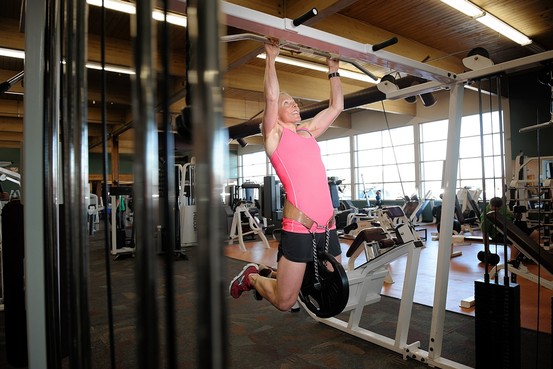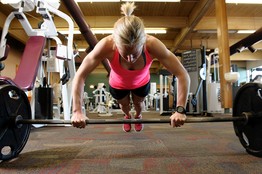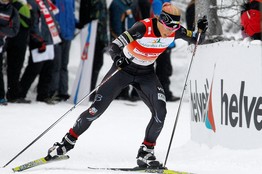A Day in the Life of a World Class Athlete
16 May 2012, Posted by in Latest News![[WORKOUTjp]](https://www.skinastc.com/wp-content/uploads/2012/05/PJ-BH144_WORKOU_G_20120514171139.jpg)
Read original article here: http://online.wsj.com/article/SB10001424052702304746604577384021387990452.html
Killer Pull-Ups, Brutal Sprints and a Nap for a Ski Champ
![[WORKOUTjp]](https://www.skinastc.com/wp-content/uploads/2012/05/PJ-BH144_WORKOU_G_20120514171139.jpg)
Mark Meyer for The Wall Street Journal
During her off-season, Kikkan Randall will run for 90 to 150 minutes on the rolling trails at what she calls a ‘conversational pace’ of eight-minute miles.
For Kikkan Randall, a cross-country skiing world champion, working out in the off-season is about far more than sliding across the snow.
Ms. Randall spends spring and summer trying to build the explosive strength her grueling event requires. “I take a couple of weeks off and go to Hawaii, and do some biking while I’m there,” she says. “But by May 1, I start training.”
Ms. Randall, the world sprint champion for the 2011-12 season, is a major star in Northern Europe, where cross-country skiing is one of the most popular sports. In the U.S., it’s something of an afterthought, even back home in Alaska, where she spends most of her off-season.

Mark Meyer for The Wall Street Journal
Cross-country skier Kikkan Randall does pull-ups with a 60-pound weight tied to her waist.
Her regimen is a brutal, six- (sometimes seven) day-a-week mix of roller skiing, biking, running and strength training. Pull-ups are a fairly unpleasant experience for most humans, but the ones Ms. Randall does resemble a form of medieval torture. She straps on a belt with a chain dangling from it and attaches a 60-pound weight to it. Or she’ll pull herself up with such power that she is able to clap her hands above the bar and then grab it to slowly lower herself. Eight is her record. “There’s nothing that makes you feel more hard core than strapping on a belt and attaching a big weight to it,” she says.
The training’s big payoff arrived in March, when Ms. Randall, 29 years old, became the first American woman to win a season-long world championship in a cross-country skiing discipline. Her next goal is to become the first American woman to win an Olympic medal in cross-country, a sport Scandinavians, Germans and Russians have dominated. The U.S. hasn’t medaled in cross-country since Bill Koch won silver in 1976.
The Workout
Ms. Randall does two workouts each day. She trains with a private cross-country skiing club at Alaska Pacific University. She meets the team at 8:30 each morning for what is usually a 2½-hour workout on roller skis. Once a week, the team has a session that lasts as long as four hours and can include runs of 12 to 15 miles on mountainous terrain.
During the regular session, Ms. Randall and her teammates spend the morning skiing intervals up and down the area’s hills. They will often cover more than 25 miles in a morning with ease, though the distance varies depending on whether the team is working on endurance or speed. Speed work requires interval training, which can be multiple one-minute bursts of sprinting with little rest in between.
The danger, Ms. Randall says, is the skis don’t come with brakes, and skiers can reach 45 miles per hour on them. “If you have to stop suddenly, you pretty much have to dive off the road,” she says. “That’s why you wear a helmet.”
After lunch and a nap, she works out on her own. Twice a week she does strength training at a local gym, though even that 90-minute session begins with a 30- to 60-minute run or roller ski. She says half of her exercises are weight-training focused on specific muscles, while the other half is focused on strengthening her core balance.
That’s where the pull-up bar comes in. Ms. Randall will hang from the bar, bring her legs up into a pike position, then slowly lower them repeatedly. She’ll do the same routine with weights strapped to her ankles. Then, keeping her ankles together and her legs raised, she’ll swing legs back and forth in front of her face like windshield wipers. “Just as I start to get good at something, my trainer figures out something to add to make it harder,” she says.
On other days, she works on her endurance, either roller-skiing or running for 90 to 150 minutes on the rolling trails near her house at what she calls a “conversational pace” of eight-minute miles. She’ll often run with ski poles, and, this being Alaska, bells or pepper spray to ward off bears or moose. “The moose have this incredible knack of getting in between me and my car right at the end of my runs,” she says.
She also works in long-distance cycling, doing road work in the summer and mountain-biking in the fall. The off-season includes a two-week ski camp in May in Bend, Ore., and another weeklong camp on Eagle Glacier in Alaska in June, where she skis five hours a day.
This year, she will put in 10 days of skiing in an indoor ski tunnel in Sweden in August, then do a weeklong camp in Fairbanks, Alaska, in late October.
The Diet
The basic formula for Ms. Randall’s diet is protein and carbohydrates during every meal and snack, with more carbs earlier in the day and more protein in the evening and before and after a weight workout.
She starts her day with an early breakfast around 7 a.m. of an egg-white omelette with fresh vegetables and whole-wheat toast. Coffee, too, is a must.
During workouts, she will snack on Power Bars and an energy drink, such as Gatorade. For lunch, Ms. Randall often has a ham or turkey sandwich with vegetables.
Dinner involves another serving of protein and fresh vegetables. She grills salmon or another meat in her backyard and makes a big salad filled with foods she struggles to find on the road: spinach, avocados, dried cranberries and peppers. Dessert is a scoop of mint-chip ice cream.
The Nap
Ms. Randall is religious about her daily nap, which can last up to two hours. Napping allows her to train as hard as she does. Growing up in Alaska, she is accustomed to falling asleep in bright daylight so she can get her usual eight to nine hours of sleep each night. “It can drive everyone else crazy, but all I need to do is climb into bed and close my eyes and I’m out,” she says.
The Gear
The Marwe Roller Skis she uses during training retail for about $349. Her LeMond Zurich road bike cost $2,860 and her Gary Fisher Cake II mountain bike lists for $2,089.
The Playlist
Ms. Randall is loyal to the goddesses of pop. Kelly Clarkson’s “Stronger (What Doesn’t Kill You)” is wearing out her headphones these days.
Motivation
She’s been dreaming of an Olympic medal since she was a teenager and she is expected to be a favorite in the 2014 Winter Olympics in Sochi, Russia, where competitors will race in the freestyle form, moving as if on skates, that Ms. Randall specializes in. “I wasn’t even alive when the last American won a medal,” she says. “So it would be pretty cool to win the next one.”



